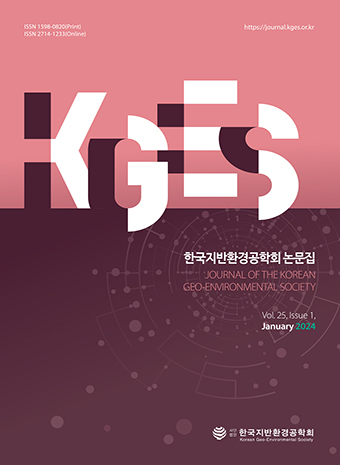-

-
A Study on the Ring Deflection According to Compaction of Buried Polyethylene Pipes
지중매설 폴리에틸렌관의 다짐도에 따른 관변형 연구
-
Seungcheol Baek, Seungwook Kim, Byounghan Choi, Sunhee Kim
백승철, 김승욱, 최병한, 김선희
- Flexible pipes have the property of resisting external loads by utilizing the rigidity of the pipe and the surrounding ground, and have …
연성관은 관의 강성과 주변 지반의 강성을 이용하여 외부하중에 저항하는 특성을 가지고 있으며, 기존의 콘크리트 관에 비해 중량이 가볍고, 내구성이 우수하기 때문에 최근 …
- Flexible pipes have the property of resisting external loads by utilizing the rigidity of the pipe and the surrounding ground, and have recently been in the spotlight because they are lighter in weight and have excellent durability compared to concrete pipes. In this study, the behavior characteristics of buried polyethylene pipe, a representative flexible pipe, were examined. Double-walled and multi-walled polyethylene pipes were used, and the structural behavior of the polyethylene pipe was evaluated based on a 5% deflection of the pipe diameter suggested in the design standards for flexible pipes. For the polyethylene pipe, the material properties of the pipe were identified through a ring stiffness test, and the behavior characteristics in the ground were reviewed through the simulation experiment of the buried polyethylene pipes. In addition, a finite element analysis model was developed based on the results of underground burial simulation experiments, and the behavior characteristics of polyethylene pipes according to backfill conditions were evaluated using the developed finite element analysis model and design equation. As a result of the study, it was confirmed that the capacity of the pipes and the compaction of the backfill are the main factors that determine the structural performance of the buried polyethylene pipe.
- COLLAPSE
연성관은 관의 강성과 주변 지반의 강성을 이용하여 외부하중에 저항하는 특성을 가지고 있으며, 기존의 콘크리트 관에 비해 중량이 가볍고, 내구성이 우수하기 때문에 최근 각광받고 있다. 이 연구에서는 대표적인 연성관인 폴리에틸렌 관을 대상으로 지중에서의 거동 특성을 검토하였다. 폴리에틸렌 관은 이중벽관과 다중벽관을 사용하였으며, 폴리에틸렌 관의 구조적 거동은 연성관의 설계기준에서 제시하고 있는 관 직경의 5% 변형을 기준으로 평가하였다. 폴리에틸렌 관은 원강성시험을 통해 관의 재료적 특성을 파악하고, 지중매설 모사실험을 통해 지중에서의 거동 특성을 검토하였다. 또한 지중매설 모사실험 결과를 토대로 유한요소해석모델을 개발하였으며, 개발한 유한요소해석모델과 설계식을 사용하여 지반조건에 따른 폴리에틸렌 관의 거동 특성을 평가하였다. 연구 결과 지중매설 폴리에틸렌 관은 관 자체의 성능과 주변 지반의 다짐 정도가 구조적 성능을 결정하는 주요 인자임을 확인하였다.
-
A Study on the Ring Deflection According to Compaction of Buried Polyethylene Pipes
-

-
A Experimental Study on Void Ration at Initiating Consolidation for Fine-Grained Soils in Korea
국내 세립토의 압밀개시 간극비에 대한 실험적 연구
-
Huiseok Hwang, Youngjin Jeon, Youngnam Choi
황희석, 전영진, 최영남
- For fine grained soils of 10 samples around coast areas in Korea, classified into three regions of West Coast, Kyungnam and Jeonnam, …
본 연구에서는 국내 해안에 분포하는 세립토의 침강압밀특성을 평가하기 위해 10개의 시료에 대하여 161회의 침강압밀실험을 수행하고, 이를 3개 권역(서해안, 경남, 전남)으로 구분하여 Yano(1985)가 …
- For fine grained soils of 10 samples around coast areas in Korea, classified into three regions of West Coast, Kyungnam and Jeonnam, settling-consolidation tests of 161 were performed to evaluate characteristics of sedimentation and consolidation during dredging and reclamation and characteristic values proposed from Yano’s method (1985) were used to analyze and assess their characteristics in this research. The settling-consolidation tests with columns of 1m in height were performed, changing initial water content and initial height of slurry, for 4, 3, and 3 samples from regions of West Coast, Kyungnam, and Jeonnam respectively. From test results effect of initial water content on coefficient of consolidation-sedimentation and initial velocity of sedimentation were analyzed, and regression equations having correlation between them were derived. The void ratios at initiating consolidation were analyzed on each samples and suggested regression equations for three regions. In addition, as a result of analyzing relation between initial void ratio of slurry and void ratio at initiating selfweight consolidation, expected ranges of void ratio at initiating consolidation for fine-grained soils from three regions of Korea coast could be proposed.
- COLLAPSE
본 연구에서는 국내 해안에 분포하는 세립토의 침강압밀특성을 평가하기 위해 10개의 시료에 대하여 161회의 침강압밀실험을 수행하고, 이를 3개 권역(서해안, 경남, 전남)으로 구분하여 Yano(1985)가 제안한 특성치로 분석 평가하였다. 침강압밀실험은 서해안권역 4개와 경남권역 3개 및 전남권역 각 3개의 시료에 대하여 높이 1m의 컬럼을 이용하여 초기함수비와 초기높이를 변화하면서 실험을 진행하였다. 각 권역별 침강압밀계수와 초기침강속도를 분석하여 대표 상관식을 제시하였다. 각 실험조건별로 자중압밀 개시 간극비를 분석하여 권역별 초기함수비와의 상관관계식을 제안하였으며, 초기 슬러리 간극비와의 관계도 분석하여 세립토의 압밀 개시 간극비 범위를 제시하였다.
-
A Experimental Study on Void Ration at Initiating Consolidation for Fine-Grained Soils in Korea
Journal Informaiton
 Journal of the Korean Geo-Environmental Society
Journal of the Korean Geo-Environmental Society
Journal Informaiton
Journal Informaiton - close
 Journal of the Korean Geo-Environmental Society
Journal of the Korean Geo-Environmental Society








